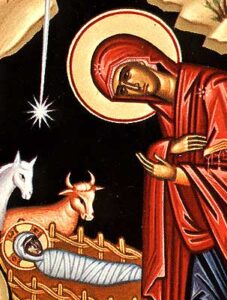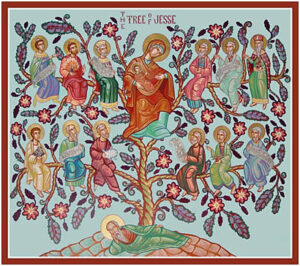
Icon - Nativity of Christ
The hymns of the Orthodox church are rich in meaning and symbolism. Unlike many Protestant churches that have hymnals that the pastor can pick and choose which hymns will be sung this coming Sunday, in Orthodoxy the priest and the church follows the prescribed order of worship down the songs and prayers. What may seem to be a stifling approach to worship allows Orthodox parishes to draw on the rich liturgical and theological heritage of the broader church.
Thou dost bear the form of Adam, yet Thou are all-perfect, being in the form of God. Of Thine own will Thou are held in human hands, who in Thy might upholdest all things with Thine hand. To Thee the pure and undefiled Virgin spake aloud: ‘How shall I wrap Thee in swaddling clothes like a child, how shall I give Thee suck who givest nourishment to all the world? How shall I not wonder in amazement at Thy poverty beyond understanding! How shall I, who am Thy handmaiden, all Thee my Son? I sing Thy praises and I bless Thee, who dost grant the world great mercy.’

Icon - Vladimir Mother of God
The undefiled Virgin, beholding the pre-eternal God as a child that had taken flesh from her, held Him in her arms and without ceasing she kissed Him. Filled with joy, she said aloud to Him: ‘O Most High God, O King unseen, how is it that I look upon Thee? I cannot understand the mystery of Thy poverty without measure. For the smallest of caves, a strange dwelling for Thee, finds room for Thee within itself. Thou hast been born without destroying my virginity, but Thou hast kept my womb as it was before childbirth; and Thou dost grant the world great mercy.’

Icon - Gifts of the Three Magis
The pure Virgin spoke in wonder, as she heard the Magi standing together before the cave, and she said to them: ‘Whom do ye seek? for I see that ye have come from a far country. Ye have the appear-ance, but not the thoughts, of Persians; strange has your journey been, and strange your arrival. Ye have come with zeal to worship Him who, journeying as a stranger from on high, has strangely, in ways known to Himself, come to dwell in me, granting the world great mercy.’
“Forefeast of the Nativity of Christ – Vespers service” — Festal Menaion, page 200.
The first stanza consists of the Virgin Mary’s contemplation of her child being the eternal Son of God. The reference to “form of Adam” echoes Romans 5:14 where St. Paul describes how the first Adam who sinned foreshadowed the second Adam (Christ) who would redeem humanity.
Nevertheless death reigned from Adam to Moses, even over those who had not sinned according to the likeness of the transgression of Adam, who is a type of Him who was to come. (emphasis added; NKJV)
The references to the “form of God” echoes Philippians 2:6-7 where St. Paul describes Christ’s great humility in emptying himself for our salvation.
Let this mind be in you which was also in Christ Jesus, who, being in the form of God, did not consider it robbery to be equal with God, but made Himself of no reputation, taking the form of a bondservant, and coming in the likeness of men. (NKJV)
The second stanza describes how the Virgin Mary accepted Christ into her life (to use the Evangelical lingo). In receiving Him she gives praise and worship to Him. This stanza gives us an insight into the icons that show her kissing her Son and her Savior.
The third stanza has missionary undertones. The coming of the Magi represent the ingathering of the nations around Christ.
Behold, these come from afar, these from the north and these from the sea, and the others from the land of the Persians. Be glad, O heavens, and rejoice exceedingly, O earth. Let the mountains break out in gladness, and the hills in righteousness. For the Lord had mercy on His people, and comforted the humble of His people. (Isaiah 49:12-13; emphasis added, NKJV)
The Christmas hymns teach important lessons about the Orthodox Faith: Christ the Second Adam who recapitulates human nature for our salvation, Mary’s joyful and loving embrace of Jesus Christ, and the missionary implications of Christ birth.
Let us like Mary the God-Bearer joyfully receive Jesus Christ into our hearts. Let us also help others discover the joy that Christ came to bring to the nations.
Robert Arakaki




Recent Comments